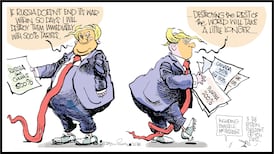Ireland has the fiscal space. Now Northern Ireland has the fiscal floor, a concept officially accepted in the financial package to restore Stormont unveiled on Monday by northern secretary Chris Heaton-Harris.
Its headline item is £2.5 billion of allegedly new money over the next few years. One-off cash injections are a very old concept in Stormont deals. The fiscal floor is a separate and far more significant part of the offer, involving a guarantee that public spending per head will never fall below 124 per cent of the level in England. As a quid pro quo, Stormont would have to raise several taxes and charges.
The fiscal floor concept originated more than a decade ago in Wales, where the devolved government sought to update how it was funded. An independent commission was set up under economist Prof Gerald Holtham to examine the Barnett formula, the method the UK treasury uses to give the devolved regions more money whenever public spending increases in England. This tends to equalise spending across the UK, a phenomenon known as the Barnett squeeze.
The commission’s report, published in 2010, said there should be a new formula based on what Wales requires to deliver the same standard of public services as England. It calculated this ‘needs-based’ figure at 115 per cent. Following a year of negotiations, the treasury agreed to guarantee it as a minimum funding level – a fiscal floor – in return for Wales taking responsibility for raising more of its own revenue. This was achieved by devolving several taxes, including a partial devolution of income tax.
READ MORE
Scotland ran its own commission at the same time but opted to keep the Barnett formula.
Little was heard of this in Northern Ireland until the DUP walked out of Stormont two years ago. Because unionist objections to the sea border cannot realistically be resolved, the party widened out its demands to budgetary reform, seeking to own the issue of introducing a fiscal floor.
Although Stormont was funded to 140 per cent of English levels as recently as 2019, that has been squeezed down to 123 per cent this year.
The 124 per cent figure was calculated by the Fiscal Council, an independent panel established under the New Decade, New Approach deal to advise Stormont on its finances. The DUP had cited this figure but now that the government has accepted it a bidding war has broken out as every party tries to own the issue. Alliance had already said the floor should be three percentage points higher due to policing costs, a claim endorsed by Prof Holtham at Westminster earlier this year. The Fiscal Council has noted it could be three points higher again due to limited tax-raising opportunities.
Looking at the needs-based calculation, it is clear Northern Ireland has genuine additional requirements
Much reaction in Northern Ireland has assumed the floor is largely determined by economies of scale, making it fixed by geography. This is a misleading simplification. The Holtham commission found need relative to England could be captured in a formula with only six variables: the proportions of the population who are under 16, retired, on benefits, from an ethnic minority, in a settlement with fewer than 10,000 inhabitants and with a long-term illness. This is how it calculated the 115 per cent figure for Wales. It scored Northern Ireland at 121 per cent, finding higher need was almost entirely due to long-term illness and low incomes, both of which increase benefit take-up.
This offers a new way of thinking about the North’s economic challenges and how to tackle them. Stormont has come to view its job as obtaining the maximum budget possible from London then dishing it out – the careless, cargo-cult mentality exposed by the renewable heat incentive.
Extra funding above English levels is seen in terms of the subvention, Northern Ireland’s £14 billion overall UK subsidy. Its simple list of major spending items does not lend itself to serious analysis. Instead, the subvention is seen through a trite constitutional prism, with unionists portraying it as British generosity that renders a united Ireland unaffordable, and nationalists portraying it as the measure of a failed state or pretending it is vastly exaggerated.
Looking at the needs-based calculation, it is clear Northern Ireland has genuine additional requirements. Some are positive, such as having more schoolchildren due to a younger population. Some are fixed by geography, such as having the UK’s most rurally dispersed population. Most are due to low productivity and poor public health, which should be the focus of policies and priorities.
There is no sign yet the Stormont parties have taken this on board, although their negotiations with the UK government have only begun. All five main parties have united to tell Heaton-Harris his fiscal floor offer should be higher. What they need to pin down is whether Stormont can reduce relative need and still keep the extra money.













